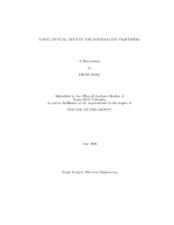| dc.contributor.advisor | Hemmer, Philip R. | |
| dc.creator | Deng, Zhijie | |
| dc.date.accessioned | 2007-09-17T19:35:43Z | |
| dc.date.available | 2007-09-17T19:35:43Z | |
| dc.date.created | 2003-05 | |
| dc.date.issued | 2007-09-17 | |
| dc.identifier.uri | https://hdl.handle.net/1969.1/5863 | |
| dc.description.abstract | Optics has the inherent advantages of parallelism and wide bandwidths in processing
information. However, the need to interface with electronics creates a bottleneck
that eliminates many of these advantages. The proposed research explores novel
optical devices and techniques to overcome some of these bottlenecks. To address
parallelism issues we take a specific example of a content-addressable memory that can
recognize images. Image recognition is an important task that in principle can be done
rapidly using the natural parallelism of optics. However in practice, when presented
with incomplete or erroneous information, image recognition often fails to give the
correct answer. To address this problem we examine a scheme based on free-space
interconnects implemented with diffractive optics. For bandwidth issues, we study
possible ways to eliminate the electronic conversion bottleneck by exploring all-optical
buffer memories and all-optical processing elements. For buffer memories we examine
the specific example of slow light delay lines. Although this is currently a popular
research topic, there are fundamental issues of the delay-time-bandwidth product
that must be solved before slow light delay lines can find practical applications. For
all-optical processing we examine the feasibility of constructing circuit elements that
operate directly at optical frequencies to perform simple processing tasks. Here we
concentrate on the simplest element, a sub-wavelength optical wire, along with a
grating coupler to interface with conventional optical elements such as lenses and
fibers. Even such a simple element as a wire has numerous potential applications. In conclusion, information processing by all-optical devices are demonstrated with
an associative memory using diffractive optics, an all-optical delay line using room
temperature slow light in photorefractive crystals, and a subwavelength optical circuit
by surface plasmon effects. | en |
| dc.format.extent | 3484843 bytes | en |
| dc.format.medium | electronic | en |
| dc.format.mimetype | application/pdf | |
| dc.language.iso | en_US | |
| dc.publisher | Texas A&M University | |
| dc.subject | Surface plasmon | en |
| dc.subject | nano wire | en |
| dc.subject | electron beam lithography | en |
| dc.subject | slow light | en |
| dc.subject | photorefractive | en |
| dc.subject | computer generated hologram. | en |
| dc.title | Novel optical devices for information processing | en |
| dc.type | Book | en |
| dc.type | Thesis | en |
| thesis.degree.department | Electrical and Computer Engineering | en |
| thesis.degree.discipline | Electrical Engineering | en |
| thesis.degree.grantor | Texas A&M University | en |
| thesis.degree.name | Doctor of Philosophy | en |
| thesis.degree.level | Doctoral | en |
| dc.contributor.committeeMember | Arnowitt, Richard | |
| dc.contributor.committeeMember | Chang, Kai | |
| dc.contributor.committeeMember | Taylor, Henry F. | |
| dc.type.genre | Electronic Dissertation | en |
| dc.type.material | text | en |
| dc.format.digitalOrigin | born digital | en |


